Слайд 2Polysemy
Is the plurality of meanings
A word that has more than one

meaning is called polysemantic
Слайд 3Polysemy
Monosemantic words (words having only one meaning) are few in number (mainly,

scientific terms)
The majority of English words are polysemantic (the number of meanings ranging from 5 to over 100)
The commoner the word, the more meanings it has
Слайд 4Polysemy is typical of English
due to the monosyllabic character of the

English vocabulary
due to the predominance of root words
Слайд 5Polysemy
Exists in the language, not in speech
Any word used actually has only

one meaning which is referred to as contextual
Слайд 6Polysemy
The sum total of many contexts in which the word may occur

permits to observe and record cases of identical meaning and cases that differ in meaning
The analysis of the word’s recurrent meanings enables to make up its semantic structure
Слайд 7Semantic structure
Is a structured set of interrelated meanings which come together due

to the proximity of notions they express
Слайд 8Table
a piece of furniture
the persons seated at a table
the food put on

a table, meals
a thin flat piece of stone, metal, wood, etc.
an orderly arrangement of facts, figures, etc.
Etc.
Слайд 9Semantic structure
In every language the combination of meanings is specific and often

depends on the grammatical categories characteristic of the part of speech to which the word belongs:
English nouns combine individual and collective, countable and uncountable variants
English verbs – transitive and intransitive lexico-semantic variants,
Etc.
Слайд 10Semantic structure
An organized set of recurrent variants and shades of meaning a

given sound complex can assume in different contexts together with their emotional colouring, stylistic peculiarities and other typical connotations
Слайд 11Polysemy
Is inherent in the very nature of words and notions as they

always contain a generalization of several traits of the object
Some of the traits prove to be common with other objects
There is a possibility of identical names for objects possessing common features
Слайд 12Approaches to the Study of Polysemy
Diachronic
Synchronic

Слайд 13Diachronically
Polysemy is the growth and development (change, in general) of the word’s
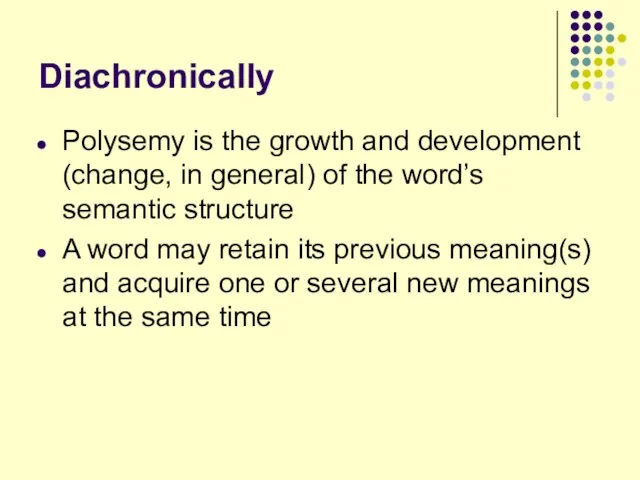
semantic structure
A word may retain its previous meaning(s) and acquire one or several new meanings at the same time
Слайд 14Diachronically
The primary meaning is the source (often etymological) meaning of the word
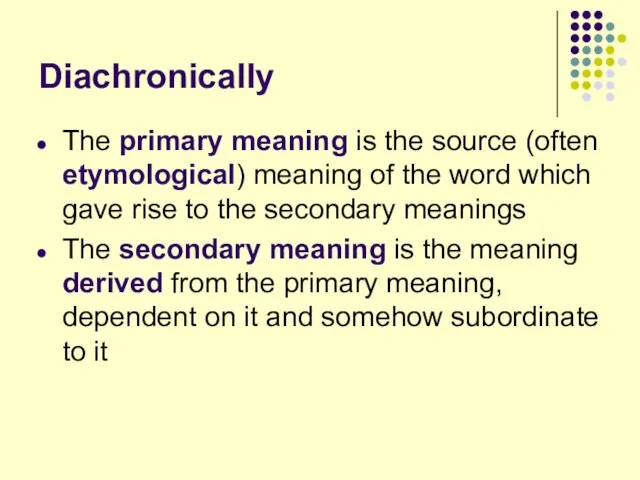
which gave rise to the secondary meanings
The secondary meaning is the meaning derived from the primary meaning, dependent on it and somehow subordinate to it
Слайд 15Table
Primary (Etymological, Old English): a flat slab of stone or wood
Secondary:
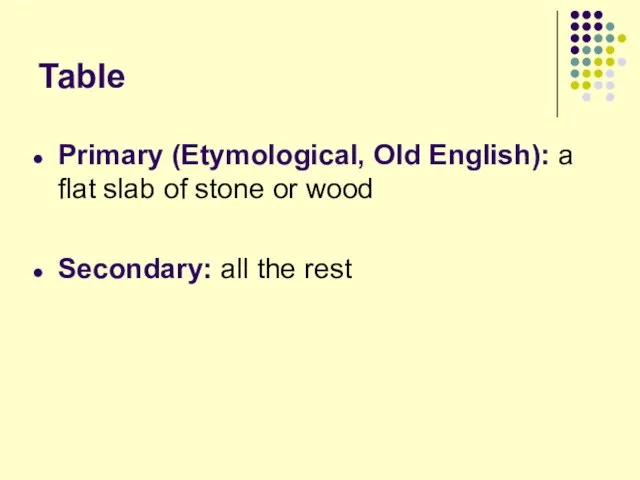
all the rest
Слайд 16Semantic development of a word
Radiation (радиальное развитие, расхождение)
Concatenation (последовательное соединение, сцепление, каскад)
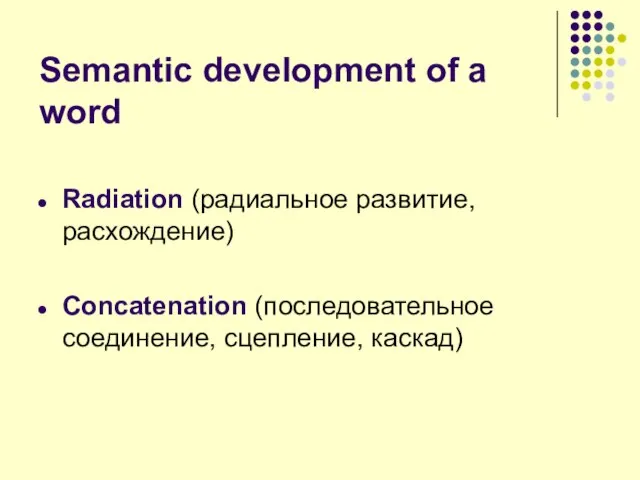
Слайд 17Radiation
The primary meaning stands in the centre and the secondary meanings proceed
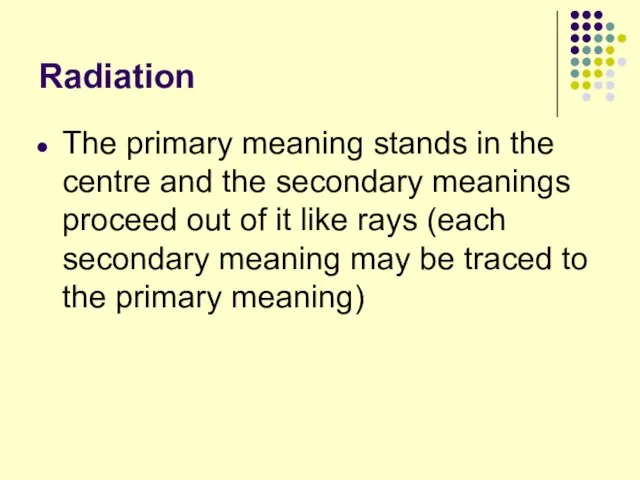
out of it like rays (each secondary meaning may be traced to the primary meaning)
Слайд 18Radiation
Face, n
Primary: the front part of the human head
Secondary:
the front
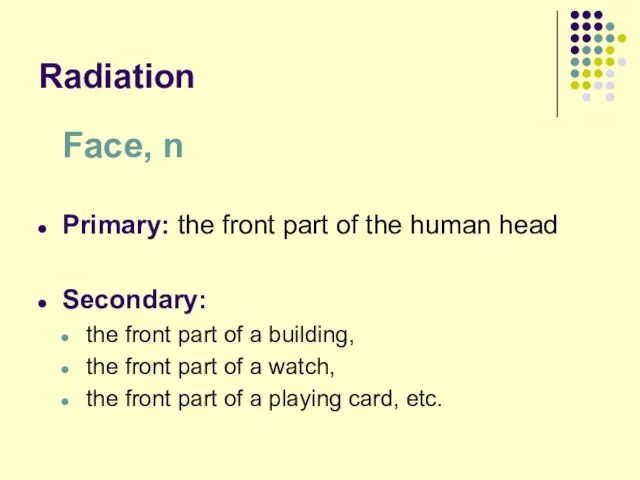
part of a building,
the front part of a watch,
the front part of a playing card, etc.
Слайд 19Concatenation
Secondary meanings of a word develop like a chain, which makes it
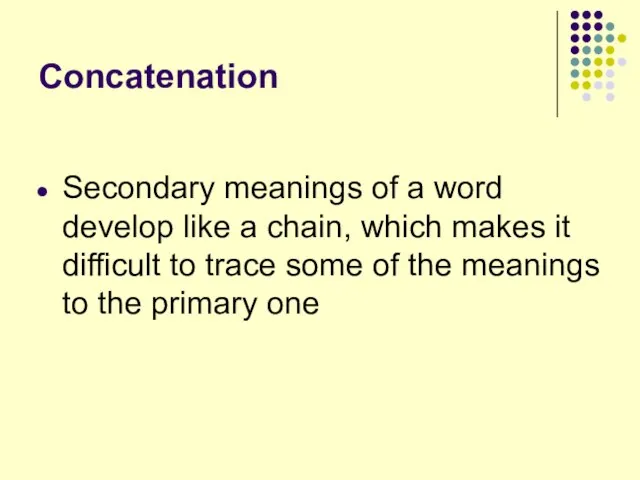
difficult to trace some of the meanings to the primary one
Слайд 20Concatenation
Crust, n
Primary: hard outer part of bread
Secondary:
Hard part of anything (a pie,
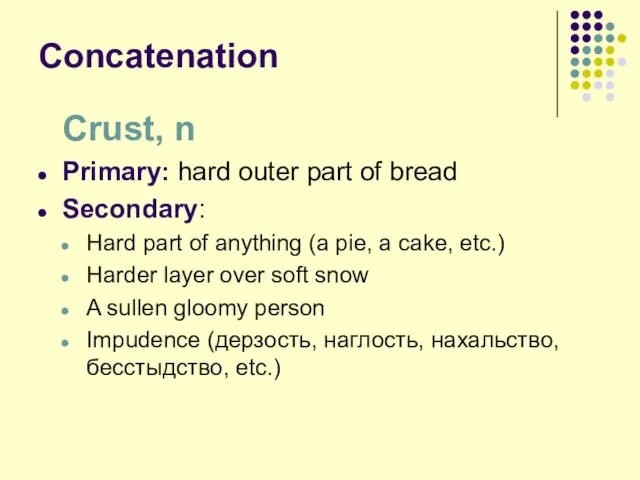
a cake, etc.)
Harder layer over soft snow
A sullen gloomy person
Impudence (дерзость, наглость, нахальство, бесстыдство, etc.)
Слайд 21Polysemy
In most cases both ways of semantic development are combined
When the
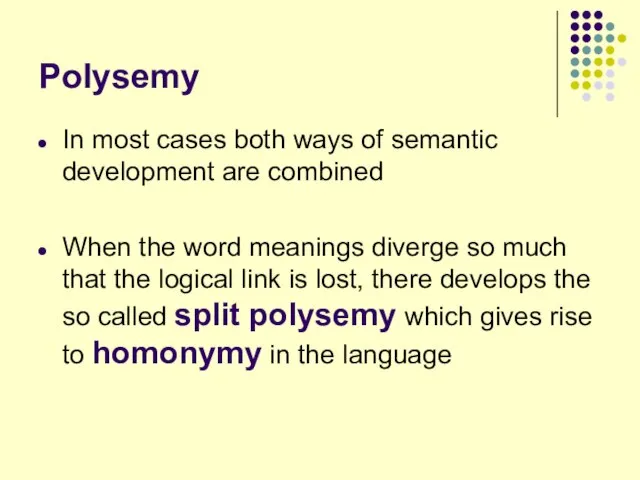
word meanings diverge so much that the logical link is lost, there develops the so called split polysemy which gives rise to homonymy in the language
Слайд 22Polysemy: the Synchronic Approach
Synchronically polysemy is defined as the coexistence of various
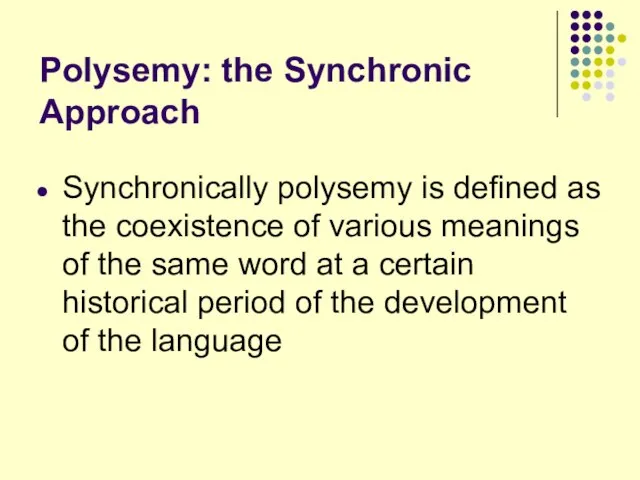
meanings of the same word at a certain historical period of the development of the language
Слайд 23Synchronically
The basic (central) meaning (criteria of differentiation):
occurs in various and widely different
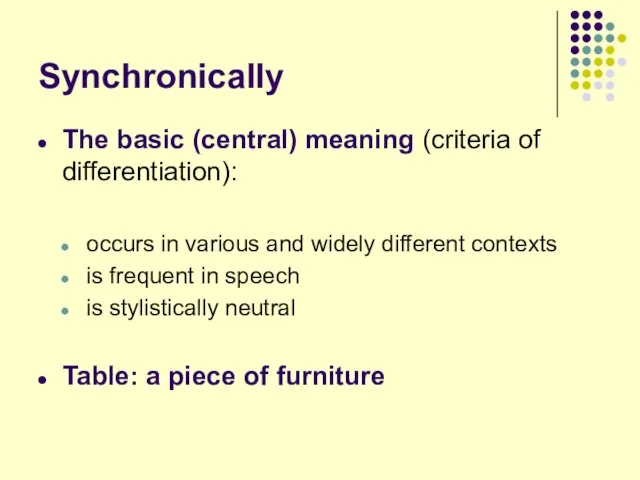
contexts
is frequent in speech
is stylistically neutral
Table: a piece of furniture
Слайд 24Synchronically
Minor (marginal) meanings (criteria of differentiation):
occur in only a few contexts
are
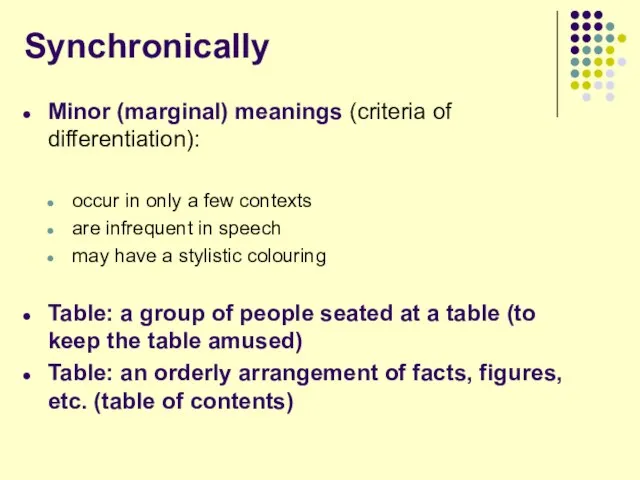
infrequent in speech
may have a stylistic colouring
Table: a group of people seated at a table (to keep the table amused)
Table: an orderly arrangement of facts, figures, etc. (table of contents)
Слайд 25Polysemy
The problem of interrelation and interdependence of various meanings of the same
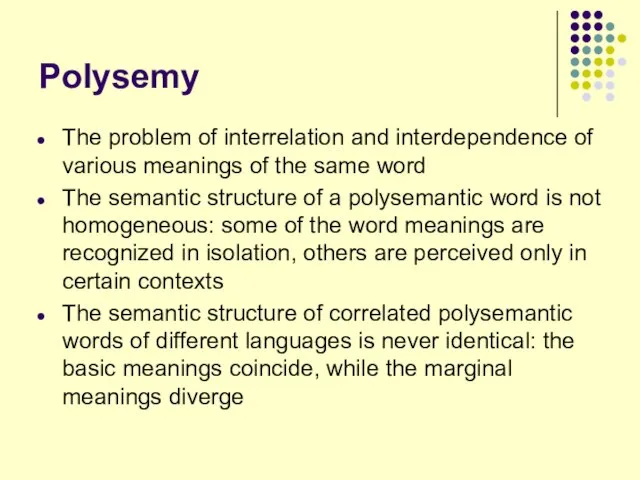
word
The semantic structure of a polysemantic word is not homogeneous: some of the word meanings are recognized in isolation, others are perceived only in certain contexts
The semantic structure of correlated polysemantic words of different languages is never identical: the basic meanings coincide, while the marginal meanings diverge
Слайд 27Homonyms
Words different in meaning but identical in sound and spelling
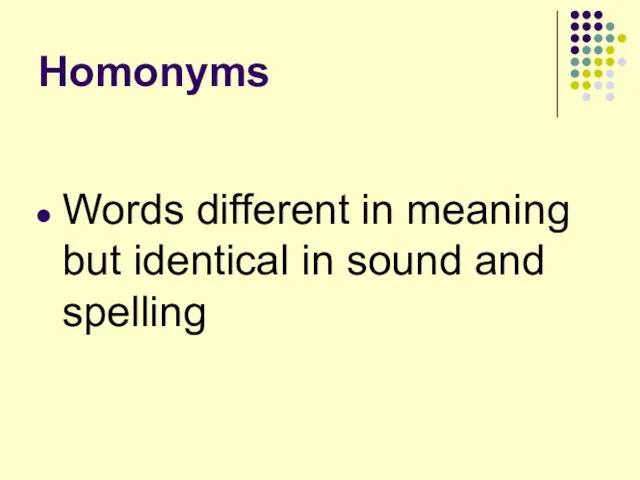
Слайд 28Sources of Homonymy
Split polysemy (divergence of word meanings so that the logical
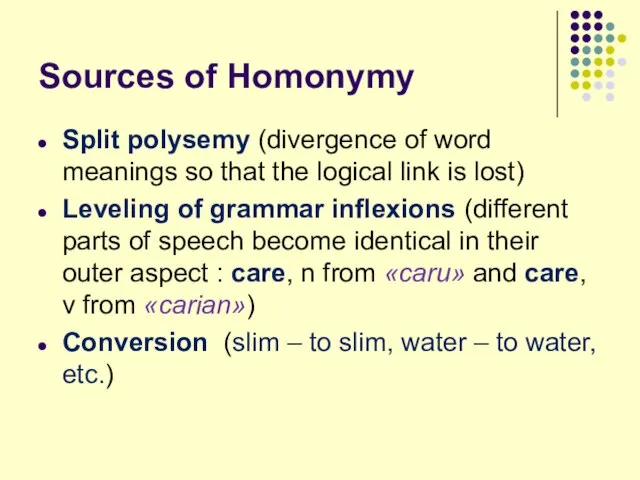
link is lost)
Leveling of grammar inflexions (different parts of speech become identical in their outer aspect : care, n from «caru» and care, v from «carian»)
Conversion (slim – to slim, water – to water, etc.)
Слайд 29Sources of Homonymy
Affixation (the same affix is added to the same stem
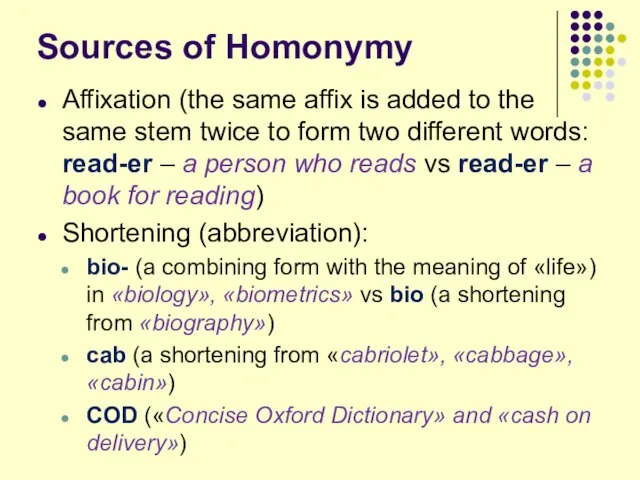
twice to form two different words: read-er – a person who reads vs read-er – a book for reading)
Shortening (abbreviation):
bio- (a combining form with the meaning of «life») in «biology», «biometrics» vs bio (a shortening from «biography»)
cab (a shortening from «cabriolet», «cabbage», «cabin»)
COD («Concise Oxford Dictionary» and «cash on delivery»)
Слайд 30Sources of Homonymy
By accident (two words coincide in their development):
bear (from
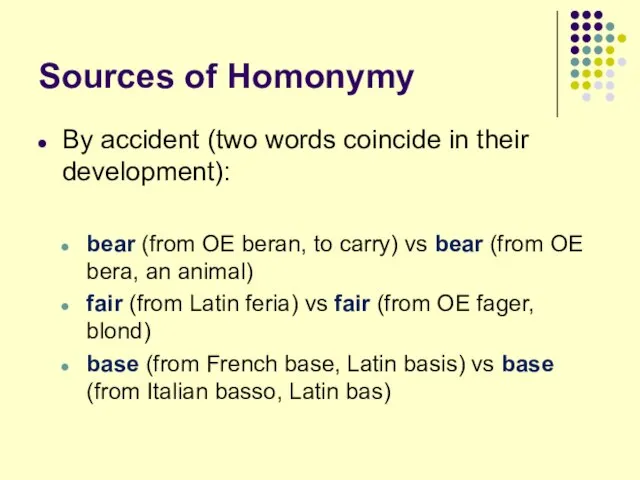
OE beran, to carry) vs bear (from OE bera, an animal)
fair (from Latin feria) vs fair (from OE fager, blond)
base (from French base, Latin basis) vs base (from Italian basso, Latin bas)
Слайд 31Classification of Homonyms:
according to the spelling and sound form
Perfect homonyms
Homophones
Homographs
(classified by Walter
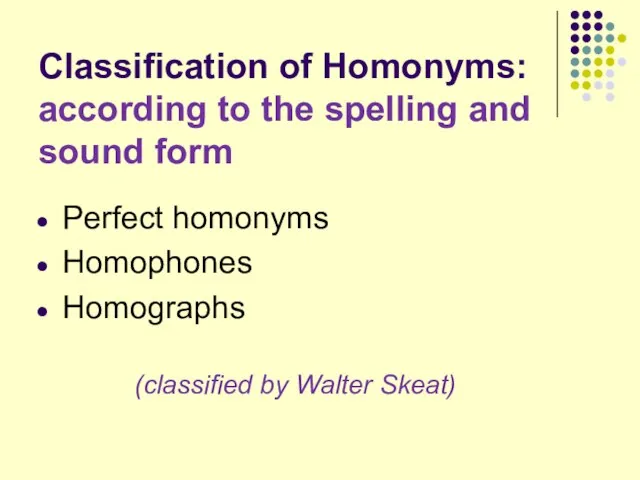
Skeat)
Слайд 32Perfect homonyms
Words identical both in sound and spelling
School – школа vs school
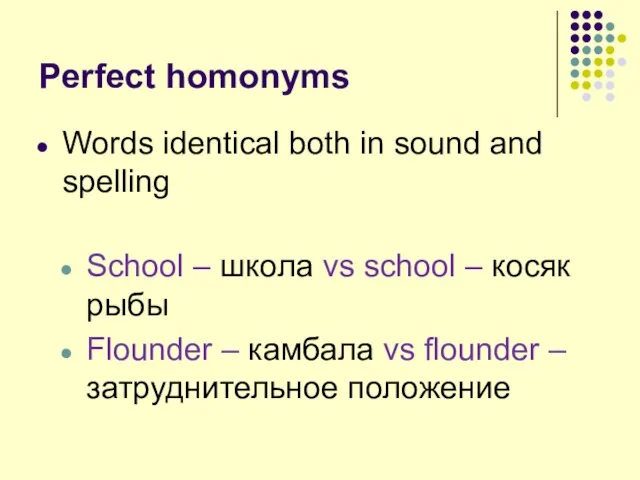
– косяк рыбы
Flounder – камбала vs flounder – затруднительное положение
Слайд 33Homophones
Words identical in their phonetics but different in their spelling
Night vs knight
Nose
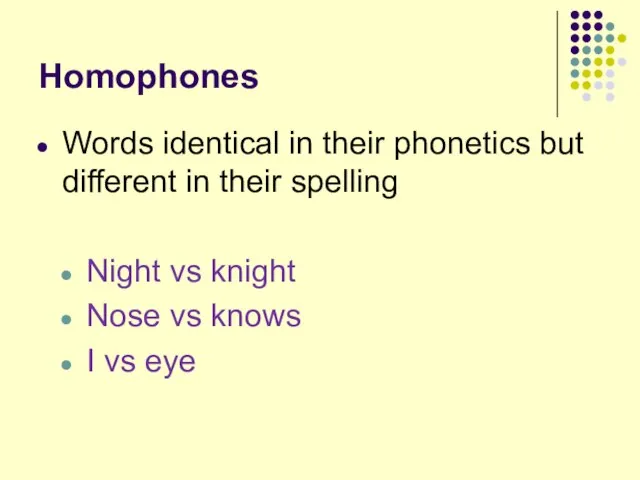
vs knows
I vs eye
Слайд 34Homographs
Words identical in their spelling but different in their phonetics
Bow [bau] –
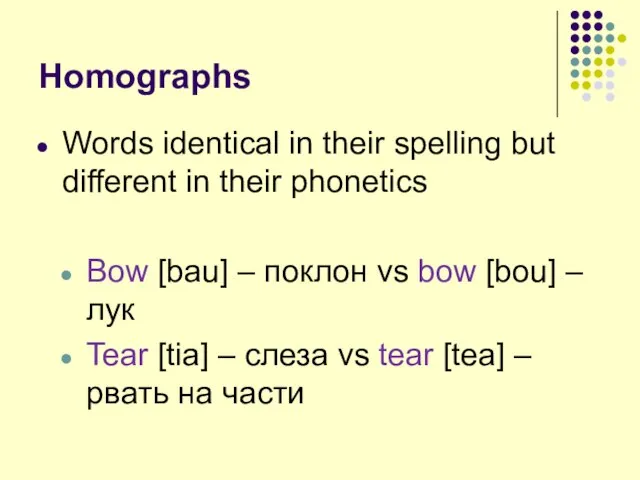
поклон vs bow [bou] – лук
Tear [tia] – слеза vs tear [tea] – рвать на части
Слайд 35Classification of homonyms: according to the grammatical meaning
Perfect (absolute)
Homoforms
(classified by A.
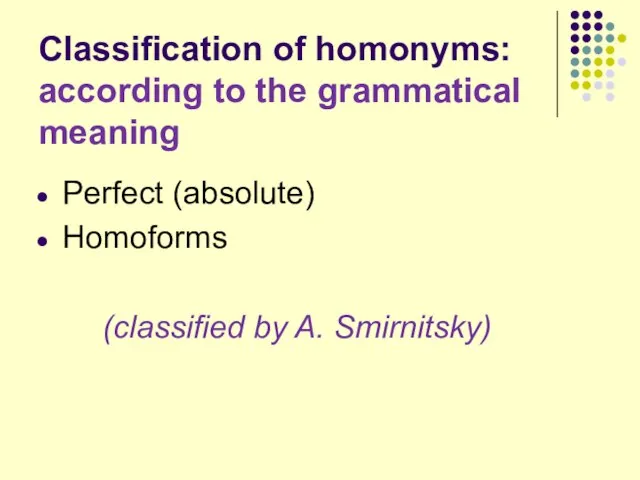
Smirnitsky)
Слайд 36Perfect (absolute) homonyms
Words which are identical in spelling, pronunciation and grammar form
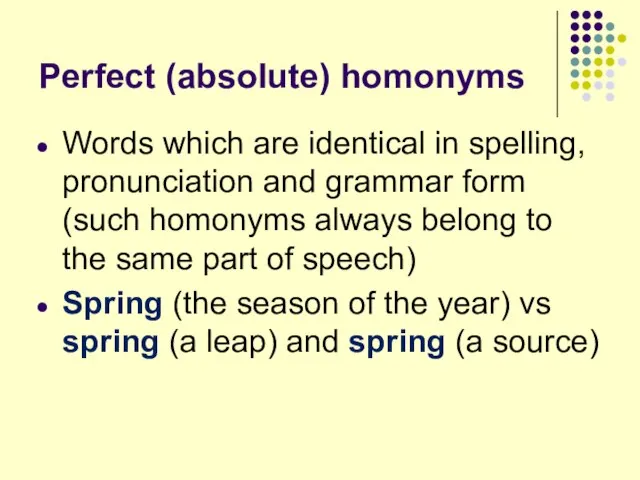
(such homonyms always belong to the same part of speech)
Spring (the season of the year) vs spring (a leap) and spring (a source)
Слайд 37Homoforms
Words coinciding in their spelling and phonetics but having different grammatical meaning
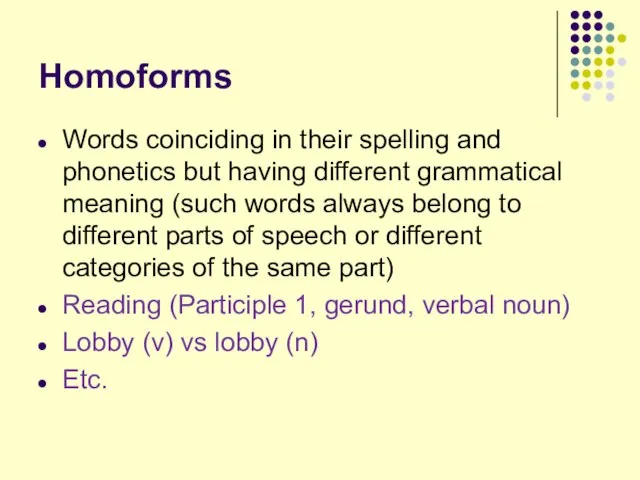
(such words always belong to different parts of speech or different categories of the same part)
Reading (Participle 1, gerund, verbal noun)
Lobby (v) vs lobby (n)
Etc.
Слайд 38Classification of perfect homonyms by I. Arnold
Criteria:
Lexical meaning
Grammatical meaning
Basic forms
Paradigms
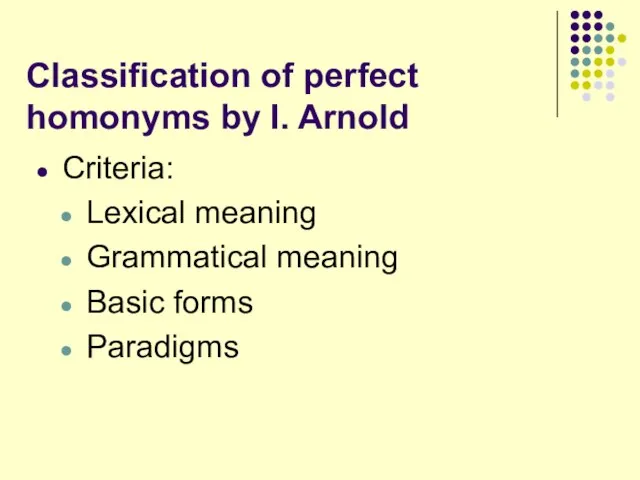
Слайд 39Group 1
Homonyms identical in their grammatical meanings, basic forms and paradigms but
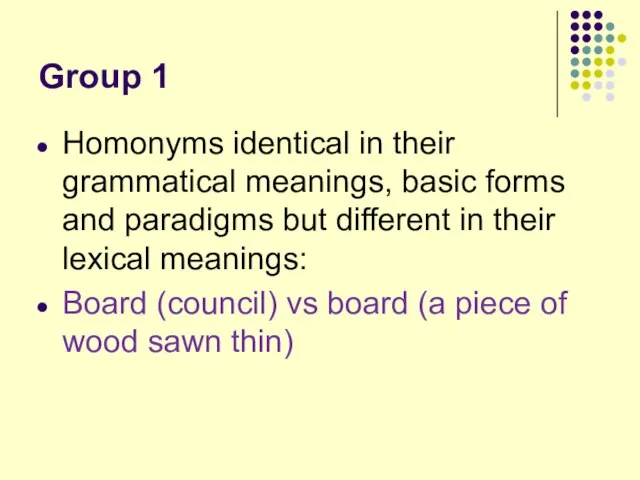
different in their lexical meanings:
Board (council) vs board (a piece of wood sawn thin)
Слайд 40Group 2
Homonyms identical in their grammatical meanings and basic forms but different
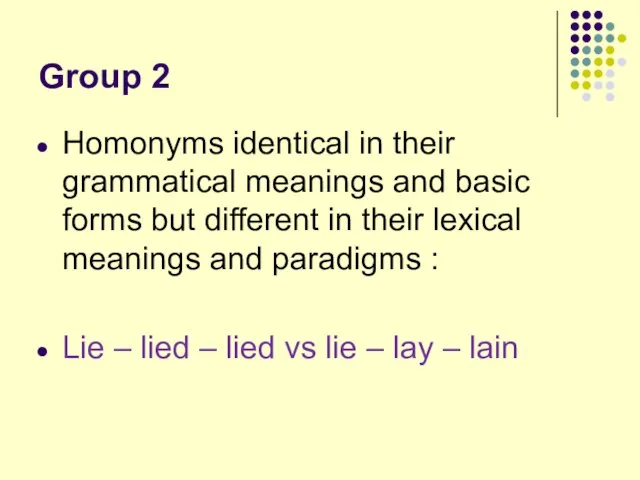
in their lexical meanings and paradigms :
Lie – lied – lied vs lie – lay – lain
Слайд 41Group 3
Homonyms identical in their basic forms but different in their lexical
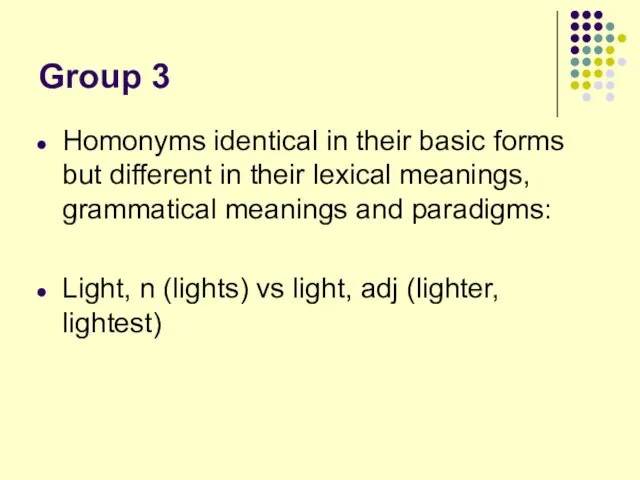
meanings, grammatical meanings and paradigms:
Light, n (lights) vs light, adj (lighter, lightest)
Слайд 42Group 4
Homonyms different in their basic forms, their lexical meanings, grammatical meanings
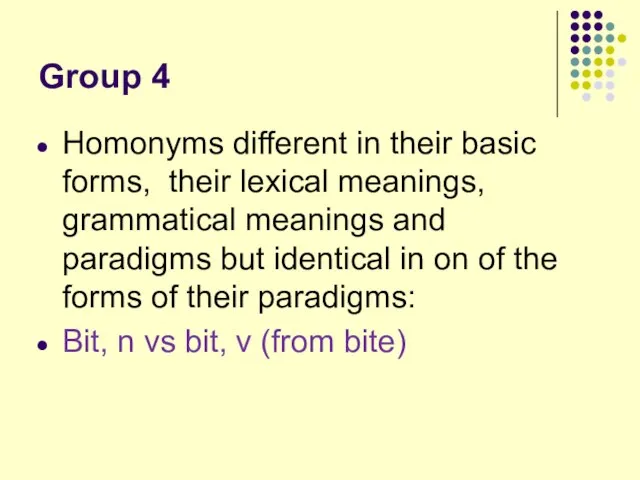
and paradigms but identical in on of the forms of their paradigms:
Bit, n vs bit, v (from bite)
Слайд 43Patterned homonyms
Homonymous words having a common component in their lexical meanings (homonyms
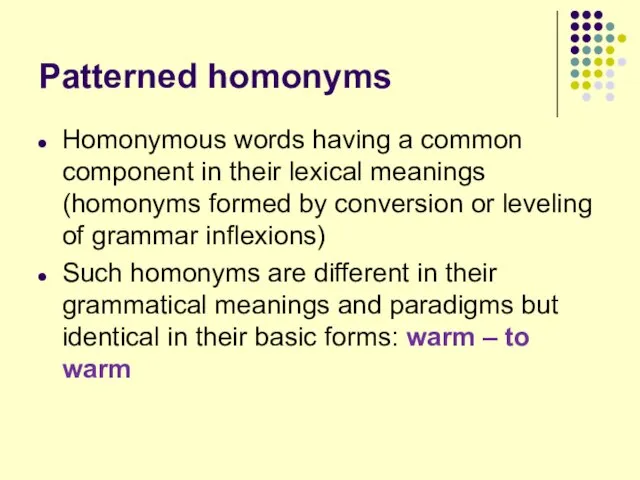
formed by conversion or leveling of grammar inflexions)
Such homonyms are different in their grammatical meanings and paradigms but identical in their basic forms: warm – to warm
























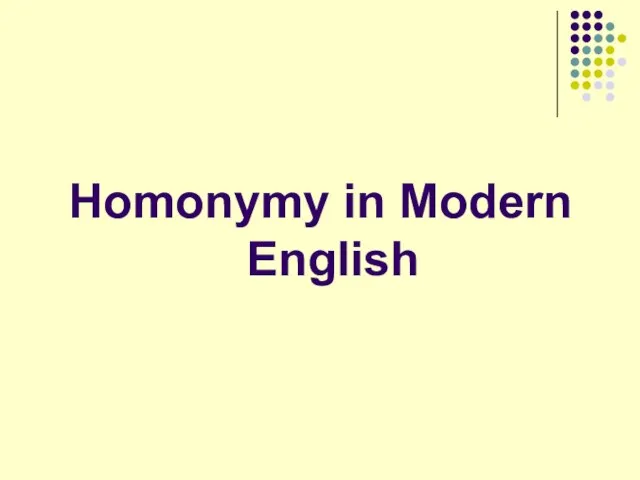

















 Интеграция Oracle Enterprise Manager (OEM)в единую систему управления данными
Интеграция Oracle Enterprise Manager (OEM)в единую систему управления данными РЕГУЛИРОВАНИЕ ВЕЩАНИЯ 3.0
РЕГУЛИРОВАНИЕ ВЕЩАНИЯ 3.0 Первобытные земледельцы и скотоводы
Первобытные земледельцы и скотоводы Пайка электромонтажных изделий
Пайка электромонтажных изделий Книжная полка:учебники и учебные пособия для преподавания русского языка как второго родного
Книжная полка:учебники и учебные пособия для преподавания русского языка как второго родного Классный турнир ГТО
Классный турнир ГТО Презентация на тему Химическое загрязнение среды промышленностью
Презентация на тему Химическое загрязнение среды промышленностью Документирование среды программирования для операционной системы L4Ka(Documenting the programmer environment for L4ka)
Документирование среды программирования для операционной системы L4Ka(Documenting the programmer environment for L4ka) Ballet music Emma Chaplin
Ballet music Emma Chaplin Презентация на тему Устный счёт на уроке математики в 1 классе
Презентация на тему Устный счёт на уроке математики в 1 классе  1
1 Конвекция
Конвекция Регистрация в поисковых системах
Регистрация в поисковых системах Зима в иллюстрациях
Зима в иллюстрациях Ресурсы подземных вод
Ресурсы подземных вод Разработчик web и мультимедийных приложений
Разработчик web и мультимедийных приложений МАТЕРИАЛ ПО KIDSMART
МАТЕРИАЛ ПО KIDSMART Программное обеспечение как услуга (SaaS)
Программное обеспечение как услуга (SaaS) Альгинатные маски Agobotorelax
Альгинатные маски Agobotorelax Секреты понимания И.А.Гончарова
Секреты понимания И.А.Гончарова Искусство веера в Китае
Искусство веера в Китае ВНИМАНИЮ ПАССАЖИРОВ, ВЫЛЕТАЮЩИХ В США!
ВНИМАНИЮ ПАССАЖИРОВ, ВЫЛЕТАЮЩИХ В США! Аммиак Выполнил ученик 9 «В»кл. Днепровский А.
Аммиак Выполнил ученик 9 «В»кл. Днепровский А. Презентация будущего
Презентация будущего Презентация на тему Экология человека и промышленное загрязнение окружающей среды
Презентация на тему Экология человека и промышленное загрязнение окружающей среды Презентация на тему Эксперимент глазами ученика и учителя
Презентация на тему Эксперимент глазами ученика и учителя Презентация на тему Важнейшие достижения в освоении космоса
Презентация на тему Важнейшие достижения в освоении космоса Вклад М. В. Ломоносова в изобретении и усовершенствование оптических приборов
Вклад М. В. Ломоносова в изобретении и усовершенствование оптических приборов